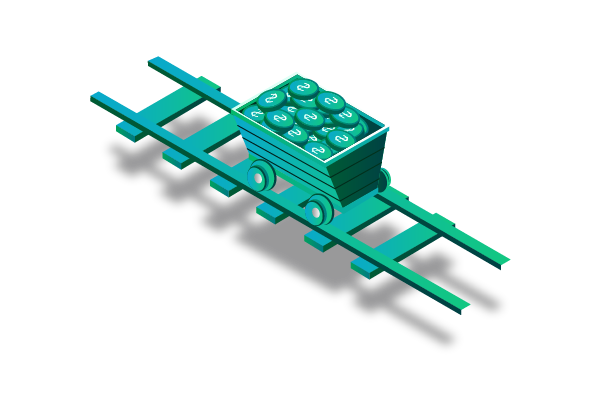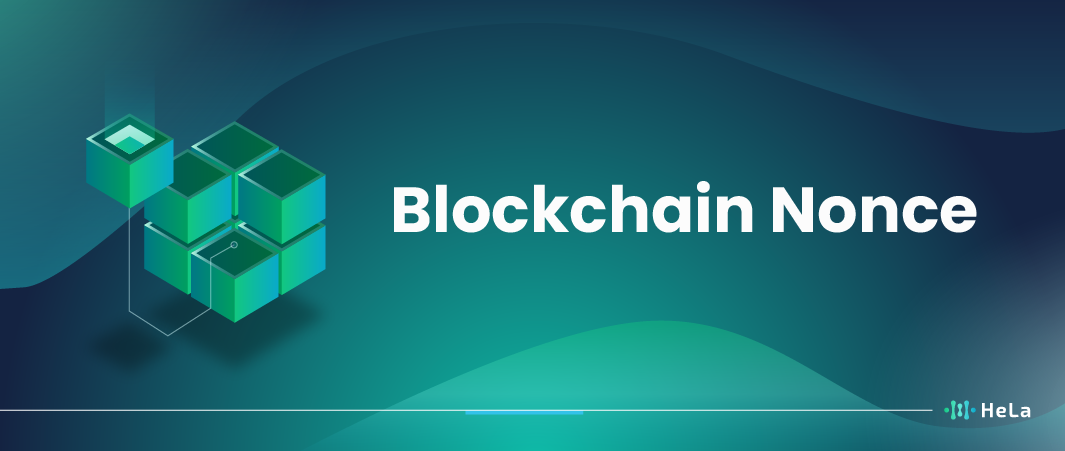In the digital world, the blockchain revolution is often celebrated for its role in empowering decentralized systems. However, within this seemingly complex landscape, there’s a critical yet often underestimated component known as the ‘nonce.’ This guide will explore the ins and outs of the blockchain nonce, shedding light on its essential role within the expansive realm of blockchain technology.
So, what exactly is a nonce, and why is it vital? Think of it as a unique and straightforward puzzle piece in the blockchain puzzle. A nonce is a number that serves as a critical part of the process that miners use to validate and add new transactions to the blockchain. It plays a central role in ensuring the security, transparency, and trustworthiness of blockchain systems. When a miner successfully discovers the right nonce for a block, it confirms the block’s legitimacy, making it an integral aspect of the blockchain’s overall security.
Now, when it comes to the broader blockchain landscape, nonces are essential for more than just security. They also contribute to the efficient operation of various blockchain-based applications and networks. This includes cryptocurrency transactions, smart contracts, and even the stability of a list of stablecoins, which are cryptocurrencies designed to maintain a stable value. In essence, the humble nonce is a fundamental building block that enables the smooth functioning of the entire blockchain ecosystem.
What Exactly is a Nonce in the Blockchain Context?
In the world of blockchain, a “nonce,” short for “number used only once,” plays a crucial role. Imagine it as a kind of unique lottery ticket that blockchain miners create and use just once in their quest to discover a new block. This concept is a key component of the proof-of-work system, which forms the basis for many blockchain systems, including Bitcoin. In simple terms, the nonce is like a secret number that miners keep changing until they find the right combination, allowing them to add a new block to the blockchain.
In a list of stablecoins, which are cryptocurrencies designed to maintain a stable value, you won’t typically find nonces being used in the same way as in cryptocurrencies like Bitcoin. Stablecoins are designed to avoid the volatility often associated with other cryptocurrencies. Instead of miners competing to find nonces, stablecoins rely on mechanisms like collateral or algorithms to maintain their value, making them a more reliable choice for everyday transactions.
The Role of the Nonce in Mining

The role of the nonce in mining is a crucial aspect of blockchain technology, particularly in the context of proof-of-work (PoW) consensus mechanisms. Mining is the process by which new transactions are added to a blockchain, and miners compete to solve complex mathematical puzzles in order to validate and secure the network. The nonce, short for “number used once,” is a fundamental component of this process.
In the context of mining, a nonce is a 32-bit (in the case of Bitcoin) or 64-bit (in some other blockchains) field in a block’s header. Miners manipulate this nonce to find a solution that, when hashed together with the rest of the block’s data, produces a hash value that meets certain criteria. This criteria is defined by the network’s difficulty level, which adjusts over time to maintain a consistent block production rate, typically around 10 minutes in the case of Bitcoin.
Miners iterate through different nonce values, changing them one by one, and hash the block header until they find a hash that is below the target difficulty level. This process is known as “proof-of-work,” as it requires miners to demonstrate that they have expended computational effort by finding a nonce that results in a valid hash.
The nonce serves several essential purposes in the mining process:
Randomization
The nonce is an arbitrary number that miners can change, allowing them to explore a vast range of possibilities in search of a valid hash. This randomization ensures that the mining process is competitive and unpredictable.
Difficulty Adjustment
As mentioned earlier, the network’s difficulty level is based on the rate at which new blocks are added to the blockchain. Miners adjust the nonce to match the difficulty level, ensuring that the average time between blocks remains relatively constant.
Also Read: List of Top Layer 1 Blockchains You Can’t Ignore!
Security
The nonce is a key element in making it computationally expensive to mine new blocks. This computational cost helps to secure the blockchain against attacks, as it would require an enormous amount of computational power to manipulate the nonce and consistently find valid blocks.
Consensus
Finding a valid nonce and block hash allows miners to propose a new block to the network. Once a block is accepted by the majority of nodes in the network, it becomes part of the blockchain, contributing to the overall consensus and ledger of transactions.
The nonce in mining plays a crucial role in maintaining the security and stability of blockchain networks that use proof-of-work consensus mechanisms. Miners must continuously adjust the nonce to find a hash that meets the network’s difficulty requirements, and this process is central to the creation of new blocks and the validation of transactions on the blockchain.
How Does Nonce Ensure Blockchain Security?

A nonce, short for “number used once,” is a crucial element in ensuring blockchain security by preventing malicious actors from tampering with the data stored in the blockchain. Let’s delve deeper into how a nonce works and its role in maintaining the integrity of a blockchain.
In a blockchain, data is structured into blocks, and each block contains a cryptographic hash of the previous block, creating a chain of interconnected blocks. This chaining mechanism makes it extremely challenging to alter any data in a single block without changing all subsequent blocks in the chain, as doing so would require re-computing the hashes for each block, which is computationally expensive and time-consuming.
The nonce is a unique, random number generated for each block during the process of mining or adding a new block to the blockchain. Miners, who are responsible for verifying and adding new transactions to the blockchain, perform a process known as proof-of-work (PoW) to find a valid nonce. The objective of PoW is to find a nonce that, when hashed along with the block’s other data, produces a hash value that meets certain predefined criteria, typically a hash with a certain number of leading zeros.
Here’s how the nonce enhances blockchain security:
Tamper Resistance
The nonce, along with the block’s data, forms the input for hashing, and the miner must find the nonce that satisfies the required hash criteria. If an attacker tries to alter any information in the block, the nonce will no longer produce a valid hash. To maintain the integrity of the blockchain, the attacker would need to find a valid nonce for the tampered block and all subsequent blocks, which is computationally infeasible.
Preventing Double Spending
In the case of cryptocurrencies like Bitcoin, the nonce also plays a vital role in preventing double spending. When a transaction is included in a block, it’s considered confirmed. Altering the transaction or block would require finding a valid nonce for that block and all subsequent blocks. This makes it extremely difficult for someone to reverse a confirmed transaction or spend the same funds twice.
Decentralization and Security
By requiring miners to find a valid nonce through a computationally intensive process, the blockchain network becomes more decentralized and secure. Malicious actors would need an enormous amount of computational power to compromise the blockchain’s integrity.
The nonce ensures blockchain security by making it incredibly challenging for attackers to tamper with the data in a blockchain. Its integration with the proof-of-work mechanism creates a robust system where altering data in a single block would necessitate redoing the work for all subsequent blocks, effectively making the blockchain resistant to unauthorized modifications and ensuring the trustworthiness of the data it contains.
Real-world Implications of Nonce in Blockchain Systems

Beyond the theoretical and technical realms, understanding nonce can have tangible benefits. For potential miners, grasping how nonce functions can help optimize mining strategies, making their efforts more efficient and potentially more rewarding. For blockchain developers, understanding the nonce’s role can guide in designing more secure and scalable blockchain solutions. And for everyday users, having a foundational knowledge of elements like nonce demystifies the technology, making it more accessible and trustworthy.
Here are some additional real-world implications of nonce in blockchain systems:
Mining Efficiency and Profitability
Miners compete to find the correct nonce to validate a block. Understanding how nonce works can help miners optimize their mining strategies. They can adjust parameters like the mining hardware, mining software, and mining pools to increase their chances of finding the nonce faster and, as a result, increase their mining rewards. A deeper understanding of nonce can lead to improved efficiency and profitability for miners.
Blockchain Security
For blockchain developers, a clear comprehension of nonce is vital in creating more secure and scalable blockchain solutions. If nonce generation is not properly designed, it can open the door to potential vulnerabilities, such as double spending and 51% attacks. By understanding nonce and its role in block validation, developers can implement better security measures to protect their blockchain networks.
Also Read: What is Litepaper? A Step-by-Step Beginner’s Guide to Writing and Formatting
User Empowerment and Trust
For everyday users and cryptocurrency enthusiasts, grasping the concept of nonce can make blockchain technology more accessible and trustworthy. It demystifies the underlying mechanisms of blockchain, helping users make informed decisions. Users can have more confidence in the security of a blockchain network and understand the importance of concepts like mining in the ecosystem.
Consensus Mechanism Education
Nonce is a critical component of the PoW consensus mechanism. Understanding how nonce works provides valuable insight into the inner workings of blockchain systems. This knowledge can be particularly helpful for those interested in blockchain technology, as it allows them to appreciate the nuances of different consensus mechanisms, like PoW and Proof of Stake (PoS).
Blockchain Governance and Upgrades
Nonce also plays a role in blockchain governance and protocol upgrades. Changes to the blockchain’s rules, such as altering the difficulty target that miners must meet, often require a collective decision by the network participants. Understanding nonce is essential for assessing the implications of such changes and their potential impact on network security and performance.
The real-world implications of nonce in blockchain systems are far-reaching and extend beyond the technical realm. Miners, developers, and users can benefit from a deeper understanding of nonce, leading to improved mining strategies, enhanced security, increased user trust, and more informed decisions in the blockchain space.
Nonce and The Evolution of Blockchain Technology
The concept of a blockchain nonce plays a crucial role in traditional proof-of-work blockchains like Bitcoin. It helps maintain the balance between making tasks neither too easy nor too difficult. However, as the blockchain landscape evolves, we’re witnessing the emergence of new consensus mechanisms such as proof-of-stake and proof-of-authority. In these systems, the role of the blockchain nonce may differ or become less prominent.
In these newer blockchain mechanisms, the fundamental principle inspired by the blockchain nonce remains relevant. Ensuring that tasks aren’t too simple or too complex is still a key goal. These mechanisms aim to enhance blockchain scalability, reduce energy consumption, and improve transaction speed, all while adapting to different security and decentralization needs.
So, while the blockchain nonce’s significance may evolve or diminish in certain blockchain systems, its core principle of maintaining task difficulty serves as a guiding inspiration in designing these innovative consensus mechanisms.
Conclusion
The world of blockchain is often viewed through a lens of complexity, with jargon and technical intricacies that can be overwhelming. However, by breaking down and understanding components like the nonce, we can better appreciate the genius behind this transformative technology.
The nonce, though a simple concept, plays a monumental role in the functionality and security of many blockchain systems. It is the silent worker, ensuring that blocks are mined with integrity, and transactions remain unalterable. As we look towards the future, with blockchain technology poised to reshape industries and societal structures, it is essential to recognize and understand the foundational elements like nonce that make this revolution possible.
Remember, every great innovation is a sum of its parts. And in the vast, intricate mechanism of blockchain, the nonce is a small yet pivotal gear that keeps the system running smoothly, securely, and efficiently.

Joshua Soriano
I am Joshua Soriano, a passionate writer and devoted layer 1 and crypto enthusiast. Armed with a profound grasp of cryptocurrencies, blockchain technology, and layer 1 solutions, I've carved a niche for myself in the crypto community.

